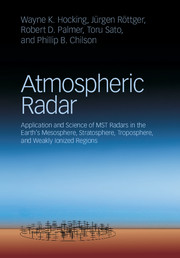 Atmospheric Radar
Atmospheric Radar Book contents
- Frontmatter
- Contents
- Preface
- Acknowledgments
- 1 An overview of the atmosphere
- 2 The history of radar in atmospheric investigations
- 3 Refractive index of the atmosphere and ionosphere
- 4 Fundamental concepts of radar remote sensing
- 5 Configuration of atmospheric radars – antennas, beam patterns, electronics, and calibration
- 6 Examples of specific atmospheric radar systems
- 7 Derivation of atmospheric parameters
- 8 Digital processing of Doppler radar signals
- 9 Multiple-receiver and multiple-frequency radar techniques
- 10 Extended and miscellaneous applications of atmospheric radars
- 11 Gravity waves and turbulence
- 12 Meteorological phenomena in the lower atmosphere
- 13 Concluding remarks
- Appendix A Turbulent spectra and structure functions
- Appendix B Gain and effective area for a circular aperture
- List of symbols used
- References
- Index
7 - Derivation of atmospheric parameters
Published online by Cambridge University Press: 25 November 2016
- Frontmatter
- Contents
- Preface
- Acknowledgments
- 1 An overview of the atmosphere
- 2 The history of radar in atmospheric investigations
- 3 Refractive index of the atmosphere and ionosphere
- 4 Fundamental concepts of radar remote sensing
- 5 Configuration of atmospheric radars – antennas, beam patterns, electronics, and calibration
- 6 Examples of specific atmospheric radar systems
- 7 Derivation of atmospheric parameters
- 8 Digital processing of Doppler radar signals
- 9 Multiple-receiver and multiple-frequency radar techniques
- 10 Extended and miscellaneous applications of atmospheric radars
- 11 Gravity waves and turbulence
- 12 Meteorological phenomena in the lower atmosphere
- 13 Concluding remarks
- Appendix A Turbulent spectra and structure functions
- Appendix B Gain and effective area for a circular aperture
- List of symbols used
- References
- Index
Summary
Introduction
The ultimate aim of any radar experiment is of course to determine information about the structures which backscatter the radio waves, and the environment in which they exist. For example, it might be of interest to study the wind speeds associated with the scatterers, or the shape of the scatterers, or to differentiate types of scatterers or reflectors. It might be of interest to determine the radar cross-section of the scatterers, or their spatial distribution over the sky. Other desired information might include the spatial and temporal variation of the scatterer velocities as a function of time and height. If the radio scatter is due to turbulence, it might be desirable to measure the intensity of the turbulence, and/or its spatial distribution. It might be of interest to determine the relative percentages of turbulent to non-turbulent scatter. The list can go on.
In the preceding chapters, we concentrated on: (i) the principles of radar (Chapters 2 to 6); (ii) signal processing procedures (Chapters 3 to 5); and (iii) the nature of the scattering mechanisms (especially Chapter 3). Now is the time to bring all this information together and look more closely at the interaction between the radar and its scattering environment. In particular, we want to determine how the radar may be used to deduce information about the scatterers themselves. This information could include all sorts of spatial scales, right down to the radar wavelength (often indirect information at such small scales), and a wide variety of temporal scales, from fractions of a second to many years.
The purpose of this chapter is therefore to discuss ways that relevant atmospheric parameters can be determined and then interpreted, in order to give new insights into the nature of the scatterers. We will re-examine some of the parameters already discussed, like spectral characteristics, and we will also introduce new ones, like the turbulence anisotropy, amplitude distributions, phase distributions, turbulence strengths, tropopause height, and so forth. Some of the approximations used in determining these parameters are also critically examined. Some consideration will be given to experimental design, and then interpretation of the results. Studies of the parameters evaluated over long periods of time can give a considerable amount of additional information, over and above that which can be determined from a few discrete observations, but discussion of this aspect will not be considered in great detail, due to lack of space.
- Type
- Chapter
- Information
- Atmospheric RadarApplication and Science of MST Radars in the Earth's Mesosphere, Stratosphere, Troposphere, and Weakly Ionized Regions, pp. 381 - 440Publisher: Cambridge University PressPrint publication year: 2016


